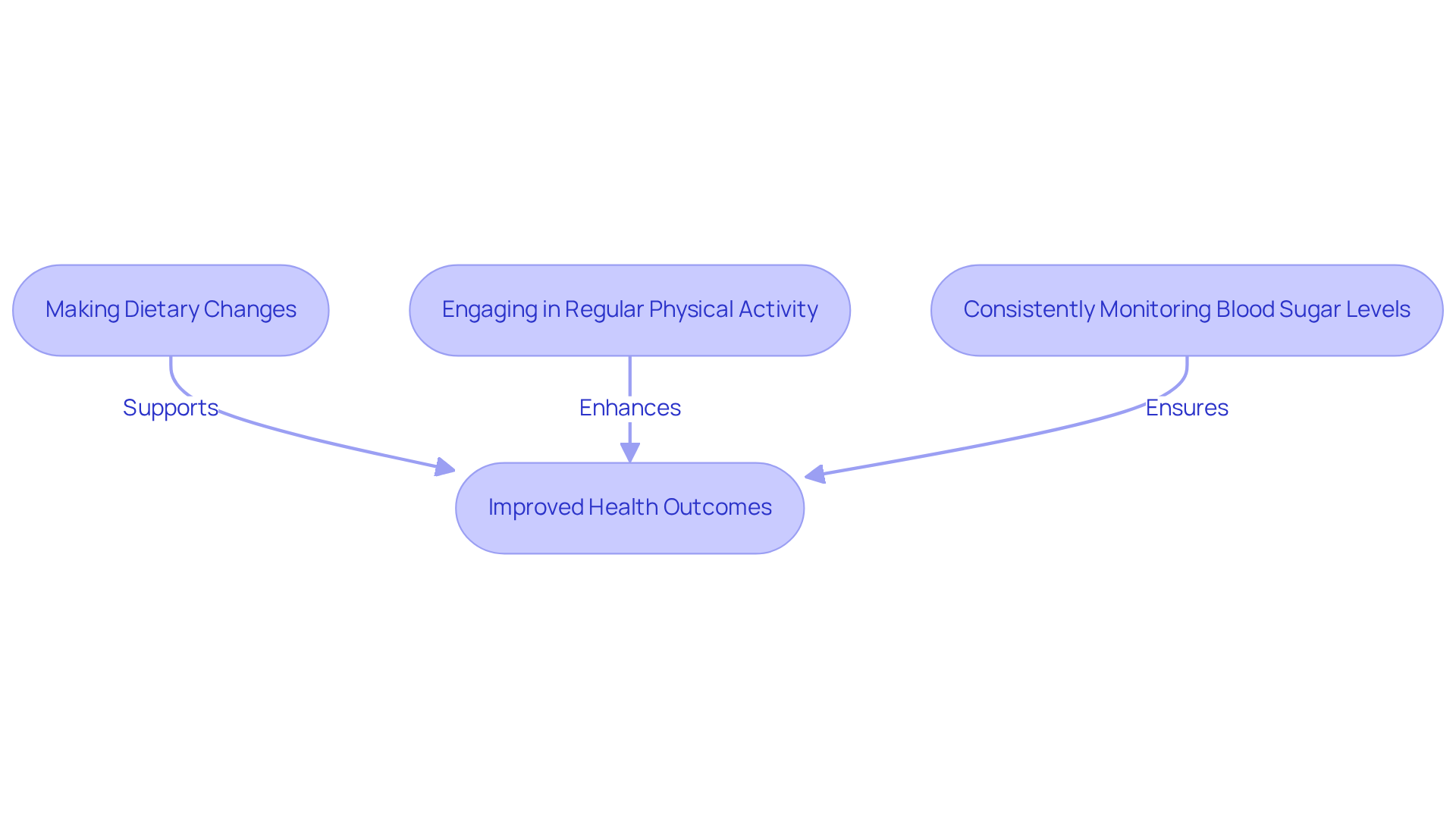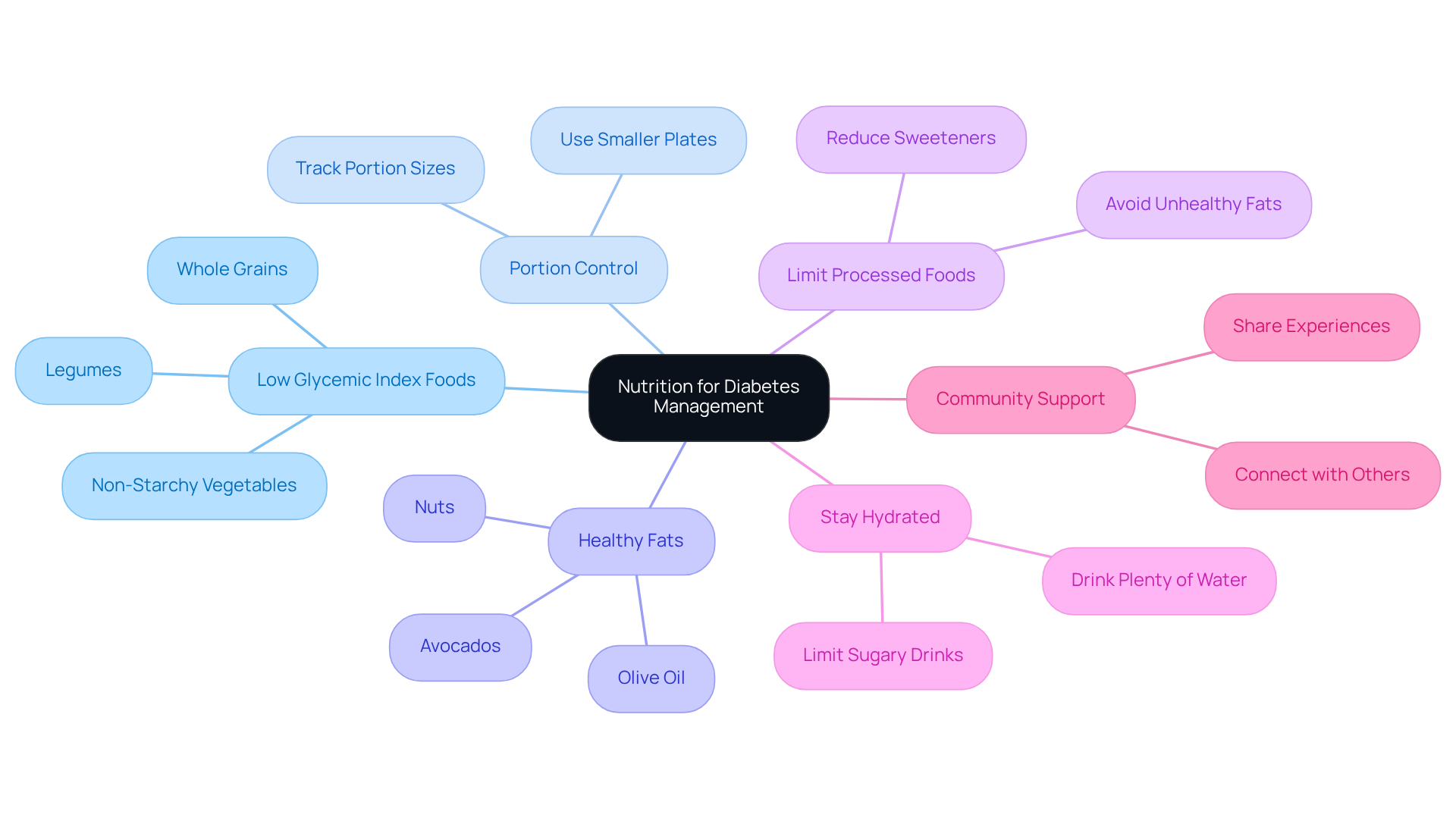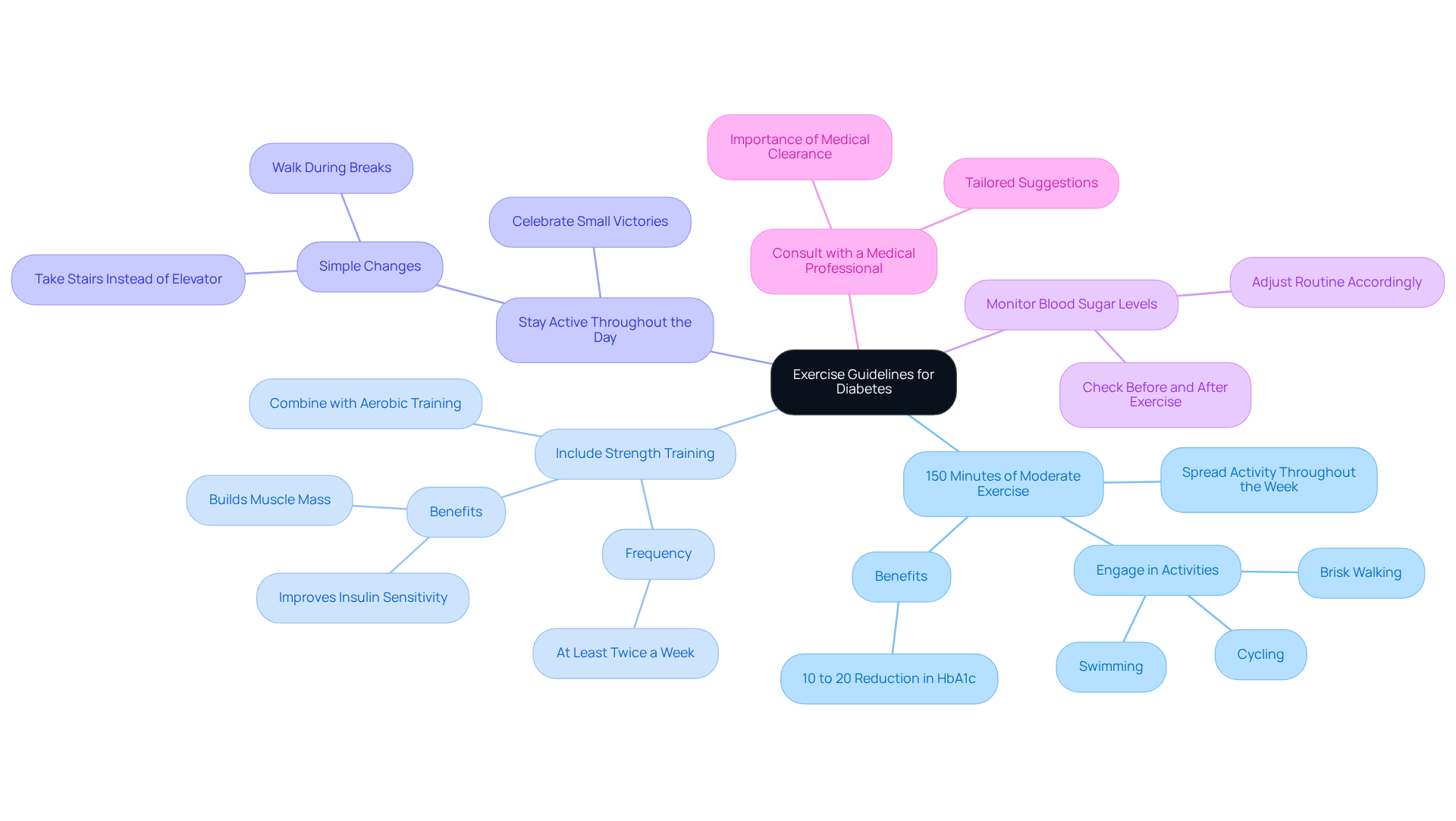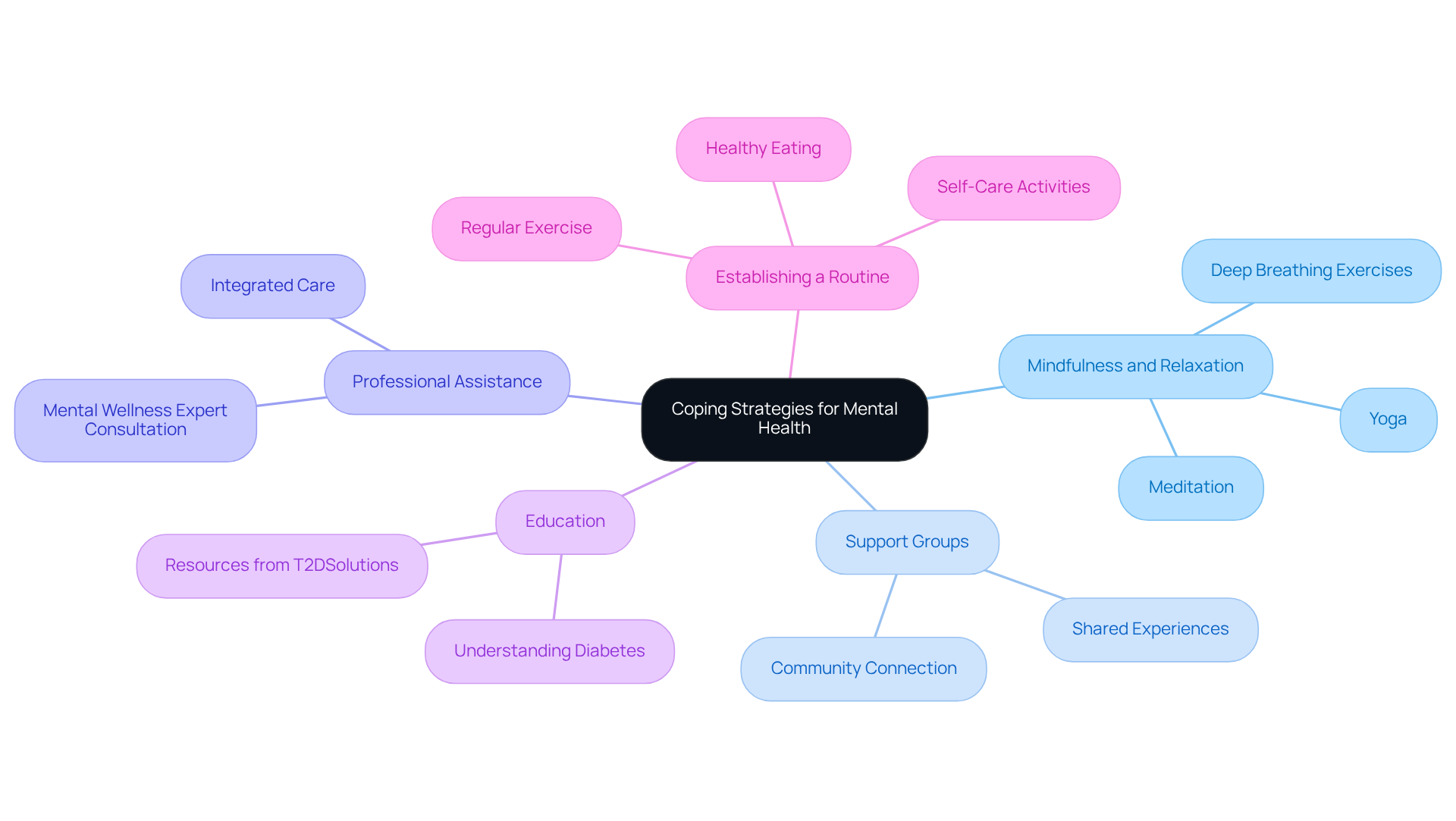Overview
Managing Type 2 diabetes can feel overwhelming, but you're not alone in this journey. Effective management involves:
- Making dietary changes
- Engaging in regular physical activity
- Consistently monitoring your blood sugar levels
Adopting a balanced diet rich in low glycemic index foods is a great first step. Alongside this, try to incorporate at least 150 minutes of exercise each week. It's understandable to feel uncertain about where to start, but utilizing community resources can significantly enhance your glucose control and overall well-being.
Remember, every small change can lead to meaningful improvements in your health. By focusing on these manageable steps, you can create a routine that supports your journey. You're not just making changes for yourself; you're also taking care of your future. If you ever feel lost or in need of support, reach out to your community—there are many resources available to help you every step of the way.
Introduction
Understanding Type 2 Diabetes is crucial, as it affects millions globally and is often linked to lifestyle choices. It's important to know that effective management of this chronic condition can significantly improve your quality of life. Strategies can range from dietary adjustments to increased physical activity. However, the journey to mastering diabetes management can bring up many questions.
- What are the most effective practices to control blood sugar levels?
- How can you navigate the emotional challenges that accompany the diagnosis?
This article delves into comprehensive strategies for managing Type 2 Diabetes, empowering you to take charge of your health and well-being. Remember, you're not alone in this journey; we are here to support you every step of the way.
Define Type 2 Diabetes: Understanding the Basics
Diabetes mellitus 2 is a long-term condition characterized by elevated glucose levels, often stemming from insulin resistance or insufficient insulin production. Unlike Diabetes 1, where the body is unable to produce insulin, individuals with Diabetes 2 can generate insulin, but their bodies struggle to use it effectively. This condition frequently develops gradually and is commonly linked to obesity, a sedentary lifestyle, and genetic factors. Understanding these fundamentals is essential for recognizing how does a person manage type 2 diabetes effectively through management strategies that can help regulate glucose levels and prevent complications.
How does a person manage type 2 diabetes? Effective management strategies for diabetes mellitus 2 include:
- Making dietary changes
- Engaging in regular physical activity
- Consistently monitoring blood sugar levels
It's understandable to feel overwhelmed by this diagnosis, but you're not alone in this journey. T2DSolutions is here to provide you with a comprehensive resource hub focused on Diabetes 2 and 3 education and community support. We offer educational resources, community programs, and expert guidance to help you navigate your condition effectively and stay informed about the latest management strategies. Together, we can work towards a healthier future.

Implement Dietary Strategies: Nutrition for Diabetes Management
Managing Type 2 Diabetes can feel overwhelming, but learning how does a person manage type 2 diabetes through a balanced diet focused on whole foods is a vital step toward feeling better. Here are some caring dietary strategies to consider:
-
Choose Low Glycemic Index Foods: Opt for foods with a low glycemic index (GI), as they cause a slower rise in blood sugar levels. Think about incorporating whole grains, legumes, and non-starchy vegetables into your meals. As Joel Fuhrman wisely states, "Your wellbeing is dependent on the amount of nutrients in your diet," highlighting how essential nutrient-rich foods are in managing diabetes.
-
Control Portion Sizes: It’s important to keep track of portion sizes to avoid excessive eating. Using smaller plates can make this easier and help maintain consistent glucose levels.
-
Incorporate Healthy Fats: Don’t forget to include sources of healthy fats like avocados, nuts, and olive oil. These can enhance heart function and help you feel full and satisfied.
-
Limit Processed Foods: Consider decreasing your consumption of processed foods that are high in sweeteners and unhealthy fats. These can lead to spikes in glucose levels, which we want to avoid.
-
Stay Hydrated: Remember to drink plenty of water throughout the day. Staying hydrated is essential for supporting your metabolic processes and overall wellbeing.
It's also important to recognize that more than 40 percent of Americans aged twenty years and older have either diabetes or prediabetes. This statistic underscores how does a person manage type 2 diabetes, highlighting the significance of dietary strategies in managing this widespread condition. By embracing these dietary methods, you can discover how does a person manage type 2 diabetes more effectively while enhancing your overall wellness.
At T2DSolutions, we understand that community support is invaluable. We encourage you to share your experiences and connect with others who are facing similar challenges. You’re not alone in this journey; together, we can enhance the management of diabetes and support one another every step of the way.

Incorporate Physical Activity: Exercise Guidelines for Diabetes
Incorporating regular physical activity into your routine is essential for understanding how does a person manage type 2 diabetes. At T2DSolutions, we understand the challenges you may face, and we serve as a valuable resource hub for diabetes education and community support. Our goal is to provide you with guidance on how to integrate exercise into your daily life, helping you feel empowered and informed. Here are some compassionate guidelines to follow:
-
Aim for 150 Minutes of Moderate Exercise Weekly: Engaging in activities such as brisk walking, cycling, or swimming can significantly improve blood glucose control. Spreading this activity throughout the week maximizes benefits, and studies show that even moderate exercise can lead to a 10% to 20% reduction in glycated hemoglobin (HbA1c). Remember, every step counts, and you're not alone in this journey.
-
Include Strength Training: Resistance training exercises should be performed at least twice a week. This not only helps improve insulin sensitivity but also builds muscle mass, which is crucial for enhancing glucose uptake in your body. Research indicates that combining aerobic and resistance training can yield greater improvements in glycemic control than either type of exercise alone. It’s about finding what works best for you.
-
Stay Active Throughout the Day: Look for opportunities to increase your daily activity levels. Simple changes, like taking the stairs instead of the elevator or walking during breaks, can contribute to your overall physical activity goals. Consistent activity during the day is associated with improved glucose control and lower cardiovascular risk. Every little bit helps, and we encourage you to celebrate those small victories.
-
Monitor Blood Sugar Levels: Regularly checking your blood sugar before and after exercise can provide valuable insights into how different activities affect your glucose levels. This practice helps you understand your body's responses and adjust your exercise routine accordingly. You're taking an important step towards understanding your health better.
-
Consult with a Medical Professional: Before beginning any new exercise routine, particularly if you have other medical conditions, it’s essential to consult with your healthcare provider. They can provide tailored suggestions that correspond to your wellness condition and fitness objectives. Remember, seeking support is a sign of strength.
By following these exercise guidelines and utilizing the resources offered through T2DSolutions, you can greatly improve how does a person manage type 2 diabetes and enhance overall well-being. We are here to support you every step of the way, encouraging a proactive approach to living with diabetes.

Support Mental Health: Coping Strategies and Community Resources
Controlling Type 2 Diabetes can be emotionally challenging, and it's important to prioritize your mental well-being for effective management. Here are several strategies to support your emotional health:
- Practice Mindfulness and Relaxation Techniques: Engaging in mindfulness practices such as meditation, yoga, or deep breathing exercises can significantly reduce stress and enhance emotional resilience. Research shows that these methods not only improve mental well-being but also help achieve better glycemic control.
- Connect with Support Groups: Joining diabetes support groups creates a sense of community and shared experiences, helping you feel less isolated. These groups provide a platform to discuss challenges and celebrate successes, which can alleviate feelings of distress.
- Seek Professional Assistance: If you're experiencing anxiety or depression, consulting a mental wellness expert who understands diabetes-related issues can be beneficial. Effective treatment for depression in individuals with diabetes has shown improvements in both mental well-being and glucose regulation, highlighting the importance of integrated care.
- Educate Yourself: Gaining a deeper understanding of diabetes can help ease anxiety. Utilizing resources from T2DSolutions empowers you with knowledge and confidence in managing your condition, which is essential for reducing stress.
- Establish a Routine: Creating a daily routine that includes self-care, exercise, and healthy eating can help manage stress and improve your overall well-being. Regular physical activity is particularly effective in controlling blood sugar levels and alleviating anxiety symptoms.
By implementing these strategies, you can enhance your understanding of how does a person manage type 2 diabetes effectively, leading to improved health outcomes and a better quality of life. Additionally, utilizing resources from T2DSolutions can further empower you in applying these strategies. It's also crucial to address diabetes distress, which is recognized as a separate issue from major depressive disorder, for comprehensive emotional support.

Conclusion
Managing Type 2 Diabetes effectively requires a comprehensive approach that combines dietary changes, physical activity, and mental health support. It's understandable to feel overwhelmed by this condition, but by understanding its nature and employing targeted strategies, you can take control of your health and improve your overall well-being.
Key strategies include:
- Making nutritious dietary choices, such as opting for low glycemic index foods and incorporating healthy fats while limiting processed foods.
- Regular physical activity; consider both aerobic and strength training exercises that can enhance insulin sensitivity and overall glucose control.
- Prioritizing mental health through mindfulness practices and community support can significantly impact your ability to manage diabetes successfully.
Ultimately, the journey of managing Type 2 Diabetes is a shared experience. You're not alone in this; by utilizing available resources and connecting with supportive communities, you can empower yourself to navigate this condition more effectively. Taking proactive steps today not only fosters better health outcomes but also promotes a richer quality of life for those living with diabetes. We are here to support you every step of the way.
Frequently Asked Questions
What is Type 2 Diabetes?
Type 2 Diabetes, or diabetes mellitus 2, is a long-term condition characterized by elevated glucose levels, often due to insulin resistance or insufficient insulin production. Unlike Type 1 Diabetes, individuals with Type 2 can produce insulin but struggle to use it effectively.
What are the common causes of Type 2 Diabetes?
Common causes of Type 2 Diabetes include obesity, a sedentary lifestyle, and genetic factors.
How does Type 2 Diabetes develop?
Type 2 Diabetes frequently develops gradually over time.
What are effective management strategies for Type 2 Diabetes?
Effective management strategies for Type 2 Diabetes include making dietary changes, engaging in regular physical activity, and consistently monitoring blood sugar levels.
Where can individuals find support for managing Type 2 Diabetes?
Individuals can find support through resources like T2DSolutions, which offers educational resources, community programs, and expert guidance focused on Diabetes 2 and 3 education and community support.



